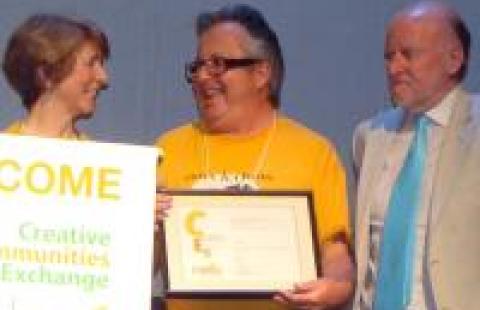What were the project goals?
RAMP uses the arts to engage with others in the preservation and revitalization of Bellows Falls and surrounding towns, which, like many other towns in Vermont and across the country, experienced severe economic and cultural decline as a result of changing economic and technological factors that rendered obsolete a great proportion of the farming and manufacturing endeavors upon which these towns had depended and thrived. Frequently the biggest impediments to preserving and redeveloping a community are the attitudes within the community itself and the failure of the community to recognize and leverage local resources, particularly the energy, creativity, and entrepreneurial power of artists.
Have they changed over time?
RAMP’s mission is to demonstrate the impact of the arts on the cultural and economic revitalization of Bellows Falls and surrounding towns, to mobilize and advocate for artists and the arts as catalysts for community re-development, and to share our experience with others facing similar challenges. For 15 years, RAMP has accomplished this programmatically by: (1) restoring and managing the Exner Block in downtown Bellows Falls, opened in 2000 and providing 10 affordable live/workspaces for artists, Project Space 9, a community gallery, and 6 storefronts for arts-related businesses; (2) curating local artists’ exhibitions in the gallery and initiating public art projects; (4) hosting Artists Town Meetings and a website and listserv for sharing of ideas, opportunities and information; (5) sponsoring an annual Memorial Day Open Studio Weekend, highlighting over 20 artists and attracting over a 1,000 people; and (6) participating on boards of directors (including the Windham Regional Commission, the National Trust for Historic Preservation, the Connecticut River National Byway and the Bellows Falls Downtown Development Alliance) to give RAMP a “voice at the table” and an opportunity to share role of artists and the arts’ in sustaining healthy communities. In addition, RAMP has shared its success in leveraging the arts to spark revitalization and foster sustainability planning through consultations with other Vermont communities (including, Morrisville, Richmond, Springfield, Putney, St Johnsbury, Readsboro, Brattleboro, Grand Isle and Brandon) and through presentations at conferences in other states throughout New England and across the country. In 2010, these included the keynote address on Rural Communities and Sustainability at the Rhode Island Annual Preservation Conference and presentations at the National Trust for Historic Preservation's annual meeting (Artists Challenging Rural Communities) and at the New England Museum Alliance's annual conference in Springfield, MA (Artists Influence on Rural Community Sustainability).
Who are the project partners and stakeholders?
The credibility and success of the Rockingham Arts and Museum Project (RAMP) depends upon its ability to meet those challenges effectively by: (i) sponsoring (on its own and collaboratively with other organizations and businesses) programs and initiatives that demonstrate the essential role that artists and the arts play in developing and sustaining the cultural and economic health of Bellows Falls and other towns facing similar challenges; (ii) making the arts accessible to the community (for example, by working closely with the Vermont Arts Council to promote universal design initiatives and ensure accessibility to all events and programs); and (iii) sharing our model for community revitalization with other communities in Vermont and other rural communities in our northeast region and across the country.
